Overview

SpiceRx provides a platform for exploring the health impact of spices and herbs used in food
preparations through a structured database of tripartite relationships with their
phytochemicals and disease associations. Starting with an extensive dictionary of 188
culinary spices and herbs, their disease associations were text mined from 28 million
MEDLINE abstracts. These data were further combined with evidence of spice-phytochemical and
phytochemical-disease associations.
SpiceRx presents a compilation of 11750 MEDLINE abstracts containing 8957 disease
associations (8172 positive and 783 negative) for 152 spices linked to 848 unique
disease-specific Medical Subject Headings (MeSH) IDs. The hierarchical organization of MeSH
was used as a basis for ontological classification of disease terms.
Spice names were tagged
using a dictionary matching method whereas diseases were tagged using a machine learning
based model, TaggerOne. A convolutional neural network based relation extraction model was
trained on 6712 manually annotated sentences to extract and classify positive, negative and
neutral associations.
Information of 866 phytochemicals was obtained for 142 of the spices using KNApSAcK
and PhenolExplorer that comprised of 570 bioactive compounds with a total of 2042
spice-phytochemical associations. These compounds were further linked to diseases with the
help of Comparative Toxicogenomics Database (CTD), a public database of literature-curated
and inferred chemical-disease associations. The resource unearths literature-supported
spice-disease associations for which the spice phytochemical(s) have been independently
reported for therapeutic effects. Thus, through interlinked triangular relationships between
culinary herbs and spices, their phytochemicals, and diseases, SpiceRx facilitates seamless
exploration of evidence-based knowledge for their disease-specific culinary recommendations
as well as enquiry into underlying molecular mechanisms.
Spice Search
Search by Spice Name

Spice search can be performed using the common name, scientific name as well as NCBI
taxonomy ID of the spice/herb. For example a user can search with the common name ‘saffron’,
scientific name ‘saffron crocus’ or NCBI Tax ID ‘82528’. The search box comes with an
autocomplete option to assist you with any spice/herb name containing a string matching with
two or more characters typed, greatly enabling the user’s ability to navigate the
database.
Spice Results Page
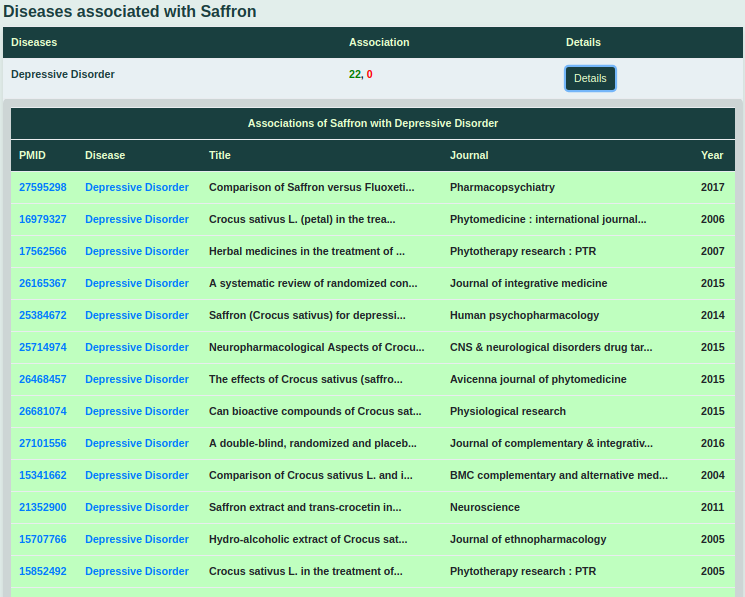
The search directs the user to the results for the spice ‘saffron’. It displays number of disease associations found for ‘saffron’, both positive and negative obtained through text mining PubMed abstracts. By clicking on the ‘Details’ tab, the user will be able to see the diseases with which ‘saffron’ is associated with. For each disease association, link to the relevant PubMed article is provided.
Phytochemicals in Spice
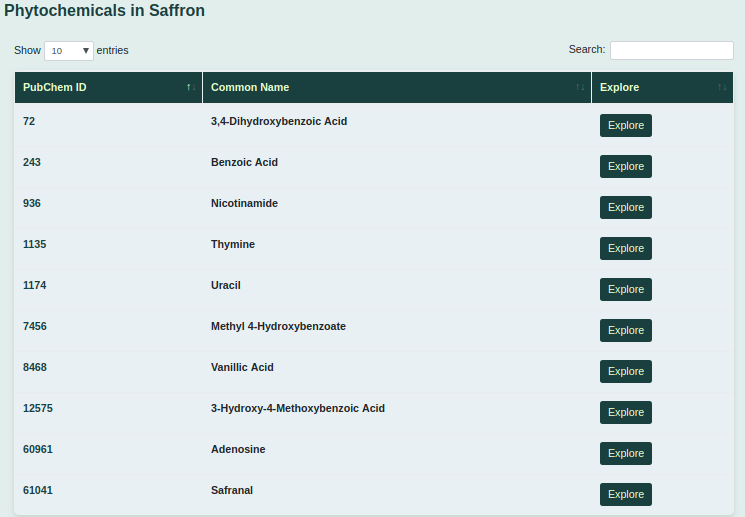
The phytochemicals present in a spice (for example ‘saffron’) is displayed in this panel. User can click on the ‘Explore’ button present against each phytochemical to obtain the its profile including chemical identifiers, 2D and 3D structure, Spices/Herbs containing the molecule and association with diseases. The ‘Phytochemical Profile’ window also facilitates finding similar molecules within SpiceRx as well as identification of those from commercially available from external resources (ZINC).
Disease Search
Search by Disease Name
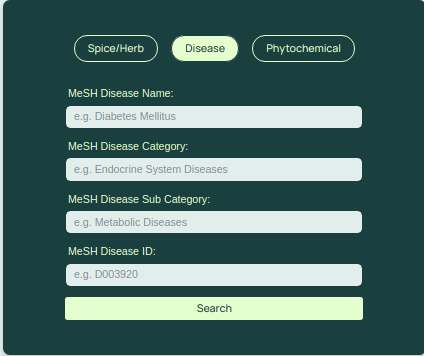
Disease search in SpiceRx is integrated with MeSH hierarchical structure for diseases. Four
types of search options are available in the disease search panel: MeSH Disease ID, MeSH
Disease Category, MeSH Disease Sub Category, and MeSH Disease Title. The MeSH Disease
category represents a broad classification of diseases such as ‘Cardiovascular Diseases’,
‘Endocrine System Diseases’ or ‘Neoplasms’.
The option ‘Disease Sub Category” represents
further refined categories of diseases such as ‘Heart Diseases’, ‘Metabolic Diseases”,
‘Liver Diseases’ etc. The option “MeSH Disease Title’ can be used to perform search for more
specific disease types such as ‘Heart Attack’, ‘Diabetes Mellitus Type 1’ etc. Users can
search for disease using its corresponding MeSH ID as well. For Example searching with MeSH
ID ‘D003922’ will provide the disease information of Diabetes Mellitus, Type 1. The user can
also perform a ‘null search’ which will display all diseases listed in the database.
Disease Results Page
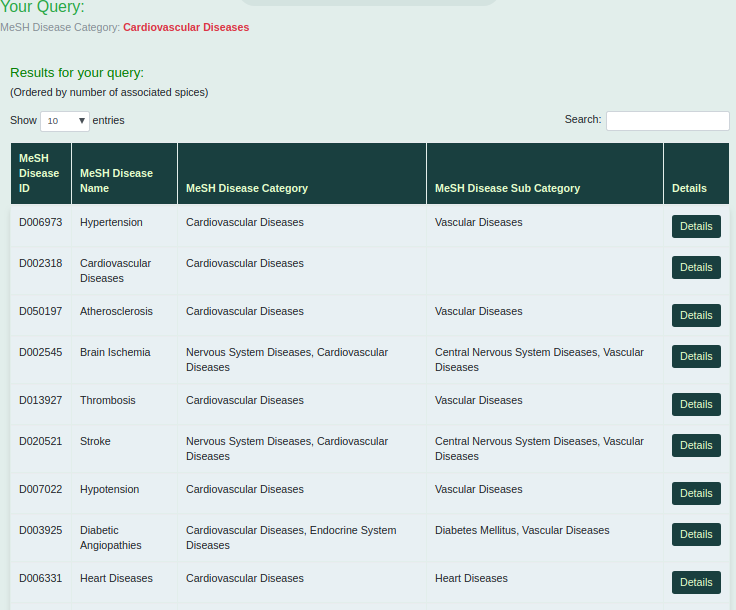
By searching any disease qualifier, the results for the disease will appear to the right of the search page. By default the first 10 results will be displayed. By clicking on the respective MeSH ID, for instance ‘D004487’, you will be redirected to the results page for that disease, in this case ‘edema’. The results page for ‘edema’ contains the details of the disease such as its MeSH category as well subcategory information. By clicking on the MeSH ID, the user can navigate to the MeSH webpage of the particular disease.
Spices/Herbs associated with Disease panel

This Panel provides the list of spices which are associated with the searched disease. The positive and negative associations are shown in green and red respectively. By clicking on the ‘Details’ tab, the details of relevant references for the association will be listed.
Linked Phytochemicals

The phytochemicals which are associated with the disease will be displayed here along with the references from PubMed. User can click on ‘Explore’ tab present against each phytochemical name to obtain the phytochemical profile and identifiers of each phytochemical.
Phytochemical Search
Search by Phytochemical
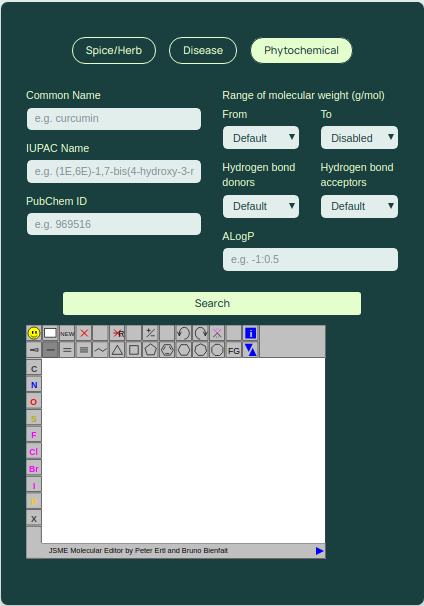
Phytochemicals search is facilitated through various options. User can search a
phytochemical with its common name, for example, ‘Piperene’, its IUPAC name, ‘(2E,4E)-5-
(1,3-benzodioxol- 5-yl)- 1-piperidin- 1-ylpenta- 2,4-dien- 1-one’ or its PubChem ID
‘638024’. The query will display the page for searched phytochemical. Users can use the
‘Explore’ tab to obtain full phytochemical profile. You may also search for spice
phytochemicals molecular weight, hydrogen bond donors/acceptors or partition coefficient
(ALogP). If the user does not have any particular phytochemical to search, they can perform
a null search which will display a list of all available phytochemicals in the
database.
Phytochemical Profile Panel
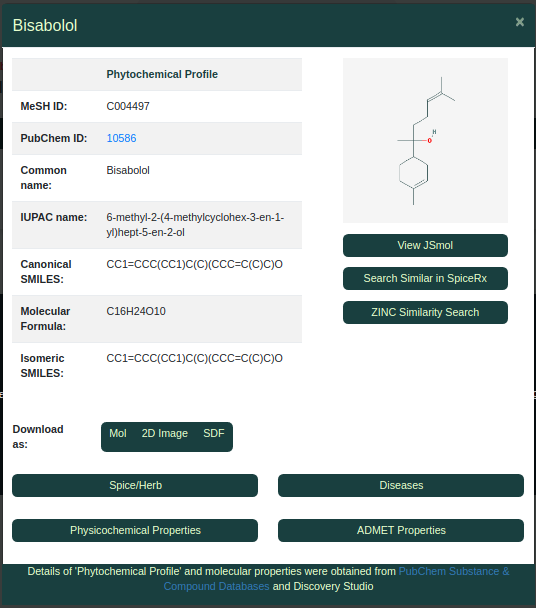
This panel provides the complete ‘Phytochemical Profile’ of the molecule searched. This
includes molecular identities such as MeSH ID, PubChem ID, IUPAC Name, Canonical and
Isomeric SMILES and the Molecular Formula. Using JSmol applet, the panel also provides 2D
image of the molecule, which transforms into 3D view upon clicking ‘View JSmol’ button.
Importantly, using structural similarity search one could either explore similar molecules
within SpiceRx, or could identify commercially available molecules from ZINC. Further, an
option is provided to download the molecule data in Mol2, SDF, 2D image, and JSON format.
Below the ‘Downloads’ button, clicking the ‘Spice/Herb’ button will provide a list of
spices/herbs in which the phytochemical is present. ‘Disease’ button will provide the list
of all diseases with which the given phytochemical is linked. Physicochemical as well as
ADMET properties of the compound can also be obtained by clicking respective tabs.
Statistics
1. Statistics of research articles reporting positive and negative disease associations for spices/herbs with 10 or more publications

Among the spices/herbs with largest number of disease associations were Garlic (782+40), Ginkgo (554+25), Turmeric (515+6) and Ginger (505+3) with more than 500 research articles reported for each. Liquorice (123) and Mugwort (49) had the largest number of negative disease associations.
2. Statistics of research articles with reports of positive and negative associations of spices/herbs corresponding to MeSH disease categories

A total of 25 MeSH disease categories were reported with therapeutic and/or adverse effects for culinary spices and herbs. Among major disease categories that are influenced by spices/herbs were ‘Pathological conditions, Signs and Symptoms’ (1690+127), ‘Neoplasms’ (1033+9), ‘Nervous System Diseases’ (859+84), ‘Nutritional and Metabolic Diseases’ (857+74), ‘Cardiovascular Disease’ (765+95), ‘Digestive Systems Disease’ (755+35), ‘Endocrine Systems Diseases’ (635+10) and ‘Mental Disorders’ (561+7), with more than 500 research articles reported for each. Together, these MeSH categories cover a large number of diseases for which diet has been reported to have major role in pathological development and progression such as diabetes mellitus type 2, obesity, coronary artery disease, hypertension, and prostate cancer, among others.
3. Statistics of research articles reporting positive associations for phytochemicals against MeSH disease categories

These data were obtained from Comparative Toxocogenomics Database. Amongst the top disease categories that phytochemicals were beneficial against were ‘Pathological conditions, signs and symptoms’ (903), ‘Nervous system disorders (629)’, ‘Neoplasms’ (303) ‘Digestive system disorders’ (283) and ‘Cardiovascular disorders’ (250).
4. Molecular weight distribution of phytochemicals

Distribution of molecular weights of phytochemicals from spices/herbs. Majority of the compounds had weight below 500 g/mol.
5. Partition coefficient distribution of phytochemicals

Distribution of partition coefficients (ALogP) of phytochemicals from spices/herbs. Majority of the molecules compounds had the partition coefficient below 5, thus fulfilling one of the criteria for drug-likeness.
Use Cases
(A) Searching for drug-like compounds in SpiceRx

One may search for spice phytochemicals which have drug-like properties using the
phytochemical search tab in SpiceRx by using criteria for fulfilling Lipinski’s rule.
Lipinski's rule specifies conditions to evaluate drug-likeness of a compound; the
suitability of a chemical compound to have pharmacological or biological activity making it
a likely candidate for orally active drug.
According to Lipinski’s rule, an orally active
drug has no more than one violation of the following criteria: No more than 5 hydrogen bond
donors; No more than 10 hydrogen bond acceptors; Molecular mass less than 500 Daltons; and
an octanol-water partition coefficient (log P) not greater than 5. By specifying these
conditions in the relevant search tabs, all compounds satisfying the above conditions can be
obtained. This search in yields 639 (74 %) of all the phytochemicals in SpiceRx (866)
suggesting the as potential therapeutic value of these compounds.
(B) Investigating molecular mechanisms behind therapeutic effects of spices and herbs.
One of the key attributes of spices and herbs are that they are antimicrobial agents.
Billing and Sherman (Billing and Sherman, 1998; Sherman and Billing, 1999) suggested that
one of the reasons for the widespread use of spices in recipes is primarily due to their
antimicrobial properties. One can search for spices and their phytochemicals which are
active against microbial infections. Searching the broad category “Bacterial Infections and
Mycosis” reveals that a wide range of culinary spices and herbs have positive associations
against this category of diseases.
Fennel and cinnamon have been reported with antimicrobial
properties against salmonella infections. Common culinary spices and herbs such as garden
thyme, oregano, clove, garlic, cinnamon, rosemary and turmeric have positive associations
against “Pneumonia Staphylococcal”. Similarly, garlic, turmeric, oregano and clove are among
spices which are reported to be beneficial for “Escherichia coli Infections”. Garlic clove
and thyme are among spices which are reported to be beneficial for “Mycosis”. Interestingly,
the molecular mechanism behind some of these antimicrobial effects of spices are yet to be
uncovered. SpiceRx provides a fertile ground for further investigations into such cases
where the molecular mechanisms for their actions are not yet evident.
Similarly, a large number of daily culinary spices and herbs have beneficial associations with Diabetes Mellitus, a common Nutritional and Metabolic Diseases. Among them, fenugreek, cinnamon, garlic, turmeric, ginger, and black cumin have been reported most frequently in literature. Beyond the three spice phytochemicals (‘gallic acid’, ‘berberine’, ‘sophoraflavonoloside’) which have been linked to diabetes mellitus, further investigations into the effects of phytochemical content in these spices can reveal their synergistic actions in disease regression and control.
(C) Hypothesis generation and knowledge discovery through SpiceRx
SpiceRx can be used as a platform for knowledge discovery and hypothesis generation. For
specific diseases, SpiceRx provides phytochemicals which are therapeutically associated with
them. By finding out the spices in which these phytochemicals occur, one can generate and
test hypothesis confirming whether these spices have beneficial effects for these diseases.
A few examples can further exemplify this point. ‘Glycyrrizin’ is a phytochemical
therapeutically associated with ‘Hepatitis A’. The phytochemical ‘Glycyrrizin’ is reported
to be found in the herb liquorice. Similarly, ‘(-)- Epigallocatechin gallate’ is another
phytochemical associated the disease ‘Herpes Simplex’. This chemical is present in various
spices such as peppermint, avocado leaf, bell pepper and german chamomile. These spices and
herbs are not directly associated with Herpes Simplex which gives room for testing the
hypothesis. Likewise, ‘Apigen’ is a phytochemical in many spices and herbs including thyme,
coriander, hyssop and fennel among others, found to be effective for Adenoviridae
Infections. No spices so far have been reported to be beneficial for Adenoviridae
Infections. Further studies can be undertaken to confirm the efficacy of spices/herbs
containing apigen against Adenoviridae Infections.